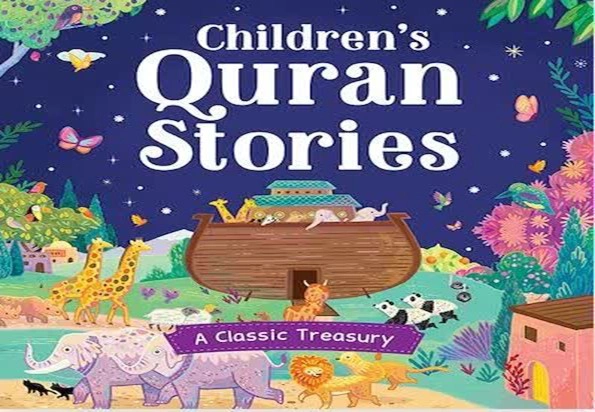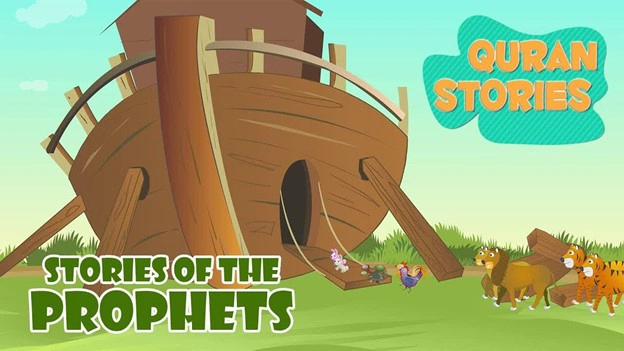Would you like to be member of Allah`s victorious party? You must fear of Allah, the Subhān, and do best in your all affairs, because surely Allah is with those who are pious and benefactor.
Ali ibn Abi Talib (as)
For children, in particular, storytelling serves as an essential tool for cognitive, emotional, and social development.
Stories are not merely a source of entertainment; they provide life lessons, develop empathy, and help children understand the complexities of human behavior and the world around them.
In this article, we explore the significance of storytelling in shaping children’s perspectives and ways of thinking, considering its influence on moral development, cultural awareness, critical thinking, and imagination.
- Stories as a Gateway to Understanding the World
Storytelling has held an allure for me since childhood. Be it listening to a narrated book, sitting around my grandmother as she shared stories, or watching movies, I was transported into these worlds, completely living the characters and their stories. Little did I then know that in years to come, such stories would become one of the most important lenses to explain the intricacies of a world around me. One of the first stories to have a tremendous impact on me was that of “The Little Prince” by Antoine de Saint-Exupéry. The story related to one little prince’s travel across other planets, which taught me much about the complexities in the human heart and the nature of love and friendships. This book taught me the very crucial values of compassion, empathy, and just how much real joy can be derived from a child’s-eye view of this world. As I got older, my reading turned to more advanced books that always forced me to look differently at the world around me.
Literary works from Harper Lee’s “To Kill a Mockingbird” and George Orwell’s “1984” have really highlighted the atrocities regarding racism, injustice, and totalitarian rule of the regimes.
These stories narrated the worst situations in society yet intensified my commitment toward social justice and activism. It helped me to understand and empathize with the thoughts and feelings of others in telling a story, allowing me to better appreciate the experiences and triumphs they were facing. Whether it be discussing the story of a young woman facing the issues that accompany growing up in “The Catcher in the Rye” by J. Whether one looks into the literary works of D. Salinger or investigates the monumental voyage of Frodo Baggins as described in “The Lord of the Rings” by J. R. R. Tolkien, both works offered me a chance to explore different perspectives and widen my knowledge. Along with literature, movies and TV series gave a new turn to my perception of narrating skills. The touching story of friendship that is “Toy Story” combined with the intellectually challenging intricacies of “Inception” gave me, for the first time, new light with which to view the question of reality. I became much more interested in those stories that challenged my preconceptions, sparked curiosity, and urged me to reconsider certain values that have already been established. Interacting with these narratives has enlightened me that there is no one right way to conceptualize the world.
Each story has a different perspective and can potentially change how we understand, believe, and feel about something. As a writer, I hope to create work that emotionally touches people, opens major dialogue, and gives them sympathy and understanding. - The Role of Stories in Moral Development
Narratives have had a central place in human culture from time immemorial, acting as one of the vehicles to pass on values and morals to successive generations. From fables and fairy tales to religious parables and canonical literature, narratives have deeply influenced the process of moral development. Another fundamental reason narrative is effective in moral development is their capacity to establish a secure environment in which one is able to explore complex ethical dilemmas and thereby ponder the consequences of their own choices. In fact, by entering into the narrative, readers and listeners may truly take on the character’s perspective and develop empathy with the character’s setbacks and successes; such attachment obviously enhances a deeper understanding of moral dilemmas and begs an individual to ponder his own personal values and decisions. Further, storytelling can also challenge prevailing social norms and promote critical thinking on social issues and injustices.
Narratives can help readers reflect on their biases and prejudices by describing characters who suffer due to adversities, discriminations, or some kind of moral dilemma. It is through the presentation of different experiences and ethical conflicts that narratives can broaden one’s understanding of the world while creating empathy and compassion toward others. Another thing is that narratives are a means to pass on cultural values and tradition from generation to generation.
Families and societies can relate values and important morals to their children through the transmission of stories that have survived over generations. These stories often carry timeless wisdom related to integrity, bravery, compassion, and resilience that serves as a seminal guiding principle in the lives of individuals as they navigate through life’s challenges. These stories have the power to inspire and mobilize people for good acts and positive changes in society.
Through the portrayal of the powerful display of virtue, heroism, and selflessness, stories have been able to inspire a moral imperative to urge people to take up the cause of what is right, often against extraordinary odds.
Whether the story is about a selfless hero that puts their well-being aside for the greater good or a community coming together to overcome a challenge, stories have the power to motive people into moral actions that bring social change. - Fostering Empathy Through Stories
Stories have been a part of the human experience for thousands of years. They are unique in making people travel to different worlds, understanding different perceptions, and through feelings that bond people. One very important aspect of storytelling is that it breeds empathy in the storyteller and the listener. Empathy is best described as one’s knack for identifying with and sharing the feelings of someone else.
It plays an important role in building interpersonal relationships, increasing understanding, and growing a caring and harmonious community. Stories have the power to evoke emotions because they enable people to view reality through the eyes of another person. This would give readers much more insight into the feelings, thoughts, and motivations behind the actions of other characters through immersive experiences in their lives, as depicted in a story. Hence, the interaction with stories of hardships, triumphs, and all sorts of hurdles experienced by others allows us to connect with the very core of what it means to be human. These things create connections between us and the characters in the story, and that therefore makes it easier for barriers to be broken down and for a feeling of unity or understanding to develop. The more we empathize with such characters, the more likely it is that we will be able to extend those same feelings to others in our lives, and to grow in our appreciation for people. Narrative methods provide an opportunity to discuss very complex themes and challenging emotions in a safe and controlled environment.
Similarly, characters facing trials or critical situations invite us to reflect upon our biases, prejudices, and preconceived notions. When we hear such stories, we are obliged to take into account different viewpoints and varied interpretations of the world, which in the end would broaden our understanding of the human condition and indeed make us more open and sensitive. Besides, it may also motivate us to act and provoke change.
And if we are emotionally moved by the failures or successes of a character, then most likely, we will be able to feel the need to make a difference in the world. We can develop characteristics like empathy, kindness, and activism in ourselves and others by creating emotional connections through storytelling.

- Cultural Awareness and Identity Formation
Stories have always played a vital role in shaping our cultural awareness and the formation of individual identity. From the stories told by our families, communities, and societies, people get to understand their place in the world and gradually learn to appreciate the diverse cultures surrounding them. Cultural awareness is the ability to recognize and appreciate the beliefs, values, customs, and traditions within different societies.
It is in interaction with the stories coming from different cultures that one may achieve deep understanding of their perspectives and ways of life. This may help to develop empathy and respect for people who are different from us, not to mention the avenue that fosters unity with the rest of the world community. On the other hand, identity formation is the process in which individuals develop a sense of their self-concept and their position in the societal structure. Narratives, in this sense, are an important tool, helping us make sense of our experiences and shaping the stories that define us.
Through the reception of narratives that embody our values, beliefs, and experiences, individuals can form a coherent sense of identity and find their place within their cultural and social environment. A very important feature of narratives is that they are able to transcend boundaries and create a bond between people from different cultures. Storytelling is a way to connect with each other and to bring different communities into a state of coherent understanding. Allowing ourselves to be attuned to the experiences shared by others will only broaden our understanding of where they are at in their lives, therefore showing a greater appreciation of their cultures. Narratives also function as an important means of culture preservation, helping to pass traditions, knowledge, and values to the next generations. By sharing our stories with subsequent generations, we can ensure that our culture is passed down in an active and engaging form that creates continuity and a sense of belonging amongst our communities. - Enhancing Critical Thinking Skills
Developing Critical Thinking through the Storytelling Techniques Critical thinking is a critical competence that allows one the ability to evaluate, analyze, and make sound decisions based on evidence and rational thinking.
This includes the ability to understand complex ideas, question accepted standards and practices, and analyze different perspectives. The skill is held in high regard within both academic and professional circles and is useful in everyday life as well. One of the most effective ways of enhancing critical thinking skills is by using storytelling.
Stories have the ability to capture our imagination, bring up emotions, and engage our intellects—they are great tools for developing critical thinking. Each time we read or come across a narrative, we get to meet diverse characters, situations, and ideas that can question our views, beliefs, and prejudices, and we are bound to question them anew. We do critical thinking through the activities of analyzing, interpreting, evaluating, and reflecting about stories.
For example, the plot of a mystery requires us to analyze clues, make logical deductions, and test other plausible interpretations. On the other hand, in a novel that addresses complex social issues, it becomes important that we reflect on our values and belief systems but at the same time consider other perspectives.
Furthermore, it often raises moral and ethical dilemmas that make us reflect critically on issues of right and wrong, good and evil.
This will increase our ability to be compassionate, reason morally, and make moral judgments. Narratives, because of the imagination and creativity they inspire, are also crucial to critical thinking.
Through interaction with those territories and their beings, one sharpens one’s cognitive mind, puts to the test one’s presuppositions, and reflects on other possibilities. In this way, you grow a mindset characteristic of innovative thinking, the framing of creative ideas, and problem-solving from a completely new angle of view. Storytelling also helps in developing better communication skills since it teaches one how to express thoughts and ideas clearly and convincingly. Sharing and discussing stories with others creates much more meaningful conversations, enables different viewpoints to be exchanged, and furthers the ability to argue a point. In a broader sense, through storytelling the opportunity exists to better the way one thinks critically. - Stimulating Imagination and Creativity
Narrative has, and remains, a powerful vehicle for the generation and expression of imagination and creativity in individuals of all ages. From fairy tales and folklore to films and novels, stories can take us to other worlds, can introduce us to different characters, different ways of looking at the world, and can even get us to dream, think, and invent. One of the key ways in which stories stimulate imagination and creativity is by engaging our minds in a process of visualization.
When we read or listen to a story, our brains work to paint a picture of the events, characters, and settings described in the narrative. More than just helping us to read the story more effectively, this visualization of the mind works by not restricting us to “standards” of what we are visually seeing but inspires us to be imaginative and lavish about what we are literally seeing. When used appropriately, although not all visualizations are effective or indeed helpful, narratives can at the least inspire us to be inquisitive and break out of the box.
Through the experiences within varied narratives, we reach a range of viewpoints, cultures, and concepts with which we would not otherwise have been confronted. This exposure can inspire us to be creative in relation to the world that surrounds us and enable us to dare to question, to inquire and to consider new ways of existing and behaving. In addition, narratives can elicit a great spectrum of feelings (such as happiness and sorrow or fear and awe).
Through emotional immersion, we can access the internal landscapes of ourselves and gain freedom to investigate the feelings and wants inside our being in a safe and predictable way. This process of emotional engagement can fuel our creativity and imagination, allowing us to channel our emotions into creative expression through art, writing, or other forms of creative endeavors. Moreover, narrative repeatedly puts us face to face, as it were, with such challenges, conflicts and dilemmas that the characters must master, learn to navigate.
Through observing these statistics over time, we can begin to gain useful and insightful knowledge about resilience, about achieving solutions to problems and about being tenacious, etc. This experience of struggle versus success may lead us to be courageous and creative in our approach to our own challenges, fostering an innovative spirit and novel solutions to our dilemmas.

- The Impact of Religious and Quranic Stories
Religious and Quranic tales have had an immense influence on human civilizations through ages. These stories, often passed down through generations, carry moral, ethical, and spiritual messages that have guided individuals in their lives and influenced societies as a whole. One of the key aspects of religious and Quranic stories is their ability to provide guidance and moral teachings.
These tales can sometimes help to tell tales of love, compassion, forgiveness, and justice, thus providing the guidance individuals need to make it through the trials of own lives and lives of others. For example, the story of Prophet Muhammad (peace be upon him)’s compassion towards all creatures, including animals, serves as a powerful reminder of the importance of kindness and empathy in our interactions with the world around us. As well as moral lessons, religious and Quranic narratives give people a feeling of identity and of belonging.
Narrative examples of trials and tribulations for prophets and the like, focusing on the strength to persevere in the face of difficulties through faith and determination, abound these stories. When people connect to these narratives, they can find strength and examples in their own struggles and hardships, knowing they are part of a bigger story of faith and tenacity. Additionally, religious and Quranic parables are used to build together a community consciousness and a sense of unity, among believers.
These anecdotes are frequently exchanged and debated amongst religious groups, building a shared worldview and common set of values that stick these people to one another. Retelling them, believers can also strengthen each other faith and heighten each other’s spiritual bond and closeness. In addition, religious and Quranic tales are a source of cultural and historical information.
These stories provide insights into the values, beliefs, and practices of different societies throughout history, offering a window into the past and helping individuals understand the complexities of human civilization. By studying these stories, individuals can gain a deeper appreciation for the diversity of human experiences and the richness of religious traditions across cultures. - Modern Storytelling and Technology
Modern storytelling has been profoundly influenced by developments in technology over the past few years. As the internet, social networks and digital web became more common, now storytellers have several options for the reach of their stories around the world. Technology has not only provided new mediums for storytelling, but it has also changed the way stories are told and consumed. One of the major ways technology has influenced modern storytelling is through the expansion of digital platforms such as Netflix, Amazon Prime, Hulu, and YouTube.
This web has enabled storytellers to produce and disseminate their work, which would not have been possible in traditional media. This has enabled a more heterogeneous spectrum of voices and stories to become audible where creators no longer need to be confined to the distribution scheme of mainstream networks. Furthermore, technology has made it easier for storytellers to connect with their audience through social media and other online platforms.
Creators are now able to interact live with their audience, provide access to their work-in-progress, and get immediate feedback on what they are doing. This direct line of communication has created a more engaging and interactive experience for both creators and audiences. Furthermore, storytelling has also been affected by technological changes.
Virtual reality (VR) and augmented reality (AR) have enabled storytellers to create immersive experiences that blur the lines between fiction and reality. Audience members no longer have the opportunity to walk into the reality of a narrative and live it for themselves but rather will experience the narrative more intensely and compellingly, rooted in a greater visceral level of narrative experience. Technology has also changed the way modern stories are told by means of data analytics and algorithms.
Streaming platforms use data to tailor content recommendations to users based on their viewing habits, creating a more personalized and curated viewing experience. Though this has resulted in worry about echo chambers as well as content homogenization, it has also opened the doors for more specific, experimental narratives to reach their audience. - Stories as a Tool for Overcoming Challenges
Stories have always been an integral part of the human culture, ever since human kind first existed. They can transport us to faraway lands, evoke powerful feelings, and provide us with the impetus to face up to challenges in life. Stories can serve as a tool for overcoming difficulties by providing us with new perspectives, emotional support, and guidance on how to navigate tough situations. Stories further, to a certain extent, help us to face these challenges by suggesting us new approaches to our own challenges.
When we dwell in the world of fictional characters or real people as portrayed in biographies, we can better understand our own lives. We will be able to empathize with the problem and difficulty of our fictional characters and, in doing so, be inspired by and find clues to our own personal problems. On the other hand, stories can also serve us as emotional support in difficult situations.
When we are exposed to the stories of people who have overcome extreme adversity, vicarious relatedness and solidarity are evoked. There can be an emotional overlay in this which allows us to feel less out on our own in our difficulties and allows us to go on in our own because others have been through similar difficulties and come out the other side stronger. In addition, narratives may provide us with practical insights into how to cope with challenging scenarios.

- Encouraging Active Storytelling Among Children
Whether from ancient myths to contemporary novels, stories have the ability to fire our imaginations and create resonance with others. Nowadays, due to the technological advancement and screen time, the importance of making children write stories in a more interactive way is crucial. Active storytelling means not only listening to stories but engaging actively in the generation and telling of stories.
There are many such formats, ranging from everyday oral narratives to literacy in the process of storytelling, narrative art and/or enactments of narrative in role-playing situations. The advantage of active storytelling is to promote the development of children’s such as creativity, imagination, and communication skills, etc.
The act of storytelling when children enter the game confronts them with tasks of critical thinking, problem-solving and imagination for forging characters, worlds and plots.
This can be used to help users to be better writers, better readers and better communicators in all respects. Furthermore, storytelling seems to enable children to develop others’ empathies and comprehension.
And when they are writing characters and situations into their stories, they can look at the world from other beings’ first person perspective and have different perspectives and understand different viewpoints.
This should enable them to develop emotional intelligence and empathy, which are critical skills for living and working in the strange environments of the world.
In addition, narrative can be a clinical tool that can help elevate self-confidence and self-esteem.
If children are told to tell everyone their story, they can witness the effect their words and thoughts have on the people in their audience. This can lead them to develop a feeling of confidence in their own skills and by so doing feel themselves to be good at things.
So how can we encourage active storytelling among children? There is, for example, one way in which they can be given opportunities to participate in storytelling, in increasing numbers of ways and formats.
This can involve, among other things, reading aloud from a storybook, attending a storytelling event or workshop, or simply prompting them to tell a story to their friends and relatives.
Parents and teachers can also play a role in gaining the children’s storytelling abilities, through open ended questions, providing feedback and encouragement and fostering a learning environment where creativity and imagination are cherished.
In Conclusion The importance of stories in shaping children’s perspectives and ways of thinking cannot be overstated. Stories are not only a source of joy but also powerful tools for moral, cognitive, and emotional development.
By fostering empathy, imagination, and critical thinking, stories prepare children for a fulfilling life. Parents, educators, and institutions should prioritize storytelling as a core component of child development.
Online Quranic Stories Course for Kids in DarulQuran Academy
The DarulQuran Academy offers an enriching Online Quranic Stories Course for Kids , designed to introduce children to the inspiring narratives of the Holy Quran.
Through engaging storytelling, children learn valuable lessons about morality, faith, and character development. This interactive course combines traditional teachings with modern methods, fostering a deep connection with Islamic values in a child-friendly environment.


